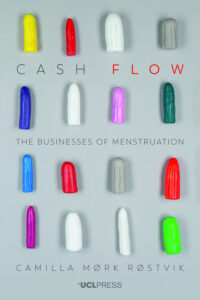Cash Flow: The Businesses of Menstruation, by UK-based academic Dr Camilla Mørk Røstvik, delves into how much we know about the menstrual industry – its surprisingly patriarchal business model, how it has amplified menstrual taboos and adapted to change. BroadAgenda editor, Ginger Gorman, put some questions to Camilla.
In a nutshell, what is your book “Cash Flow” about?
The menstrual product industry has played a large role in shaping the last hundred years of menstrual culture, from technological innovation to creative advertising, education in classrooms and as employers of thousands in factories around the world. How much do we know about this sector and how has it changed in later decades? What constitutes ‘the industry’, who works in it, and how is it adapting to the current menstrual equity movement?
Cash Flow provides a new academic study of the menstrual corporate landscape that links its twentieth-century origins to the current ‘menstrual moment’. Drawing on a range of previously unexplored archival materials and interviews with industry insiders, each chapter examines one key company and brand: Saba in Norway, Essity in Sweden, Tambrands in the Soviet Union, Procter & Gamble in Britain and Europe, Kimberly-Clark in North America, and start-ups Clue and Thinx. By engaging with these corporate collections, the book highlights how the industry has survived as its consumers continually change.

Cash Flow: The businesses of menstruation (cover image)
If we think back in history, periods have been subject to all kinds of strange myths and taboos around the globe (and in some cultures, this is still the case). Why do you think this is? How does feminism, patriarchy and capitalism fit in here?
There are many complex reasons, including menstruation’s association with dirt, femininity, and reproductive cycles – all of which have been stigmatised in some cultures.
Other scholars have written about this, recently Dr Josefin Petterson in Menstrual dirt – An exploration of contemporary menstrual hygiene practices in Sweden (2022).
Since my book covers the industry, I can add that the Western corporations who produce menstrual products are really good at both capitalising on these myths and taboos (about menstruation being unclean and that menstrual blood should not be seen for instance), while also attempting to challenge other taboos (about buying menstrual products or talking about menstrual cups for instance).
Recently I went looking for stock photos for an article about period poverty. And I was shocked at how sanitised and cliched the photos were. In the context of your book, how would you respond to this?
For menstrual scholars and activists, illustrating our work has been challenging because of the continued taboo against showing menstrual visually, especially blood. Therefore, most work is illustrated by products – thus reinforcing the industry’s hold on the visual culture of this bodily event, and even acting as product placement.
However, this is changing. I would recommend that everyone check out the open access free stock photo gallery Vulvani, a great NGO that has created free, creative and bold images of menstruation. (Editor’s note: Thanks Camilla for recommending this site! We got the feature image from there.)
I use these in a lot of my work, alongside the existing archival material that exists from for example Wellcome Trust Collections and the Schlesinger Library at Harvard. And, of course, the work of artists like Judy Chicago, Bee Hughes, Jay Critchley and others challenge the visual gap with menstrual art!

A classic example of the kind of sanitised and unrealistic stock image BroadAgenda editor Ginger found when she searched under “menstruation.” The stock image caption was listed as: “Hygienic white female pad.” Source: Shutterstock
How has the menstrual “industry” shaped the past hundred years of menstrual culture across society…everything from innovation, advertising, and even education in classrooms?
The industry has changed menstrual culture by commercialising it from around 1920 onwards (more or less one hundred years, although earlier patents and products did exist). The shift from homemade solution to store-bought purchasing, however, is neither all good or a great evil.
Many people were happy to start buying products and stop making/washing their own. It freed up time. For others, the additional cost – what we call period poverty today – was a challenge. Since we are talking about such a huge percentage of humanity, it’s difficult to generalise.
In my book, I offer some lenses through which to see the industry through. Namely, as a Western-dominated system (the first key corporations all came from what we might consider the global north), that has subsequently exported both products and Western ideas about menstruation to the rest of the world.
This includes the insistence of purchasing products, keeping bloodstains invisible, normalising euphemisms and advertising, and focus on negative aspects, for example premenstrual syndrome or PMS.
Another lens is the industry as a massive employer throughout the world, historically mostly of women. As such we can see it as a core part of modern capitalism and labour history.
A final lens to explore the industry with is its role as educator. The education it has given through the decades is not always of good quality, but they have at times stepped in when no-one else did. As such, the industry remains complicated and kept under surveillance of its own users: menstruators are both users, critics and moderators of this industry and its technologies.

Dr Camilla Mørk Røstvik believes it’s important to examine the menstruation industry, in order to create more transparent systems for scholars and consumers. Picture: Supplied
Things are currently changing. How? And how is the industry responding?
Menstrual issues are on the agenda due to the work of activists in many countries. They put the spotlight on period poverty, menstrual health, menstrual education, pain and disease related to the cycle, period positivity (in the words of Chella Quint) and menstrual rights.
This has been amplified by the industry, which has both appropriated and spotlighted these messages in advertising since about 2015.
But the industry also has a much longer history of trying to engage with menstrual activism, seen as far back as in the start of its work when core messaging revolved around liberating women from this ‘curse’ and inconvenience.
From you view is this increased visibility of menstruation a move towards social equity, or simply and increased business opportunity to sell new products?
Probably both, and historically this has also happened.
You suggest the industry is secretive and unexamined. Please unpick this for us.
Like any corporation that is still operating, the core brands in this space do not let independent scholars in (with some exceptions).
This is not unique to this industry, but happens here too.
It’s perhaps a bit more important in this industry, since there is a lack of trust between some consumers and brands. The TSS (toxic shock syndrome) issue lingers on, and the #MyAlwaysExperience debate a few years back is a reminder that it still happens. And also because the industry collectively fronts a message about being a good friend to its consumers.
You forensically look at a number of specific menstrual brands. Why is it important to see this as a corporate business that makes money?
Hopefully, it is part of creating a more transparent systems where scholars and consumers understand more about the industry. The industry’s own market research (paywalled and very expensive) documents every little detail about the consumer, so I think it’s only right that the consumer and scholar document the industry’s history.
- Dr Camilla Mørk Røstvik is Lecturer in Modern & Contemporary Art History at Aberdeen. She specialises in 20th and 21st century visual culture, with a longstanding research interest in the history, cultures, and art of menstruation. Her interests include feminist art history and art projects, environmental humanities, medical humanities, feminist Science & Technology Studies, and Norwegian/Sámi art histories.
Please note: The stock image at top came from Vulvani.
Ginger Gorman is a fearless and multi award-winning social justice journalist and feminist. Ginger’s bestselling book, Troll Hunting, came out in 2019. Since then, she’s been in demand both nationally and globally as an expert on cyberhate and the real-life harm predator trolling can do. She's also the editor of BroadAgenda and gender editor at HerCanberra. Ginger hosts the popular "Seriously Social" podcast for the Academy of the Social Sciences in Australia. Follow her on Twitter.





